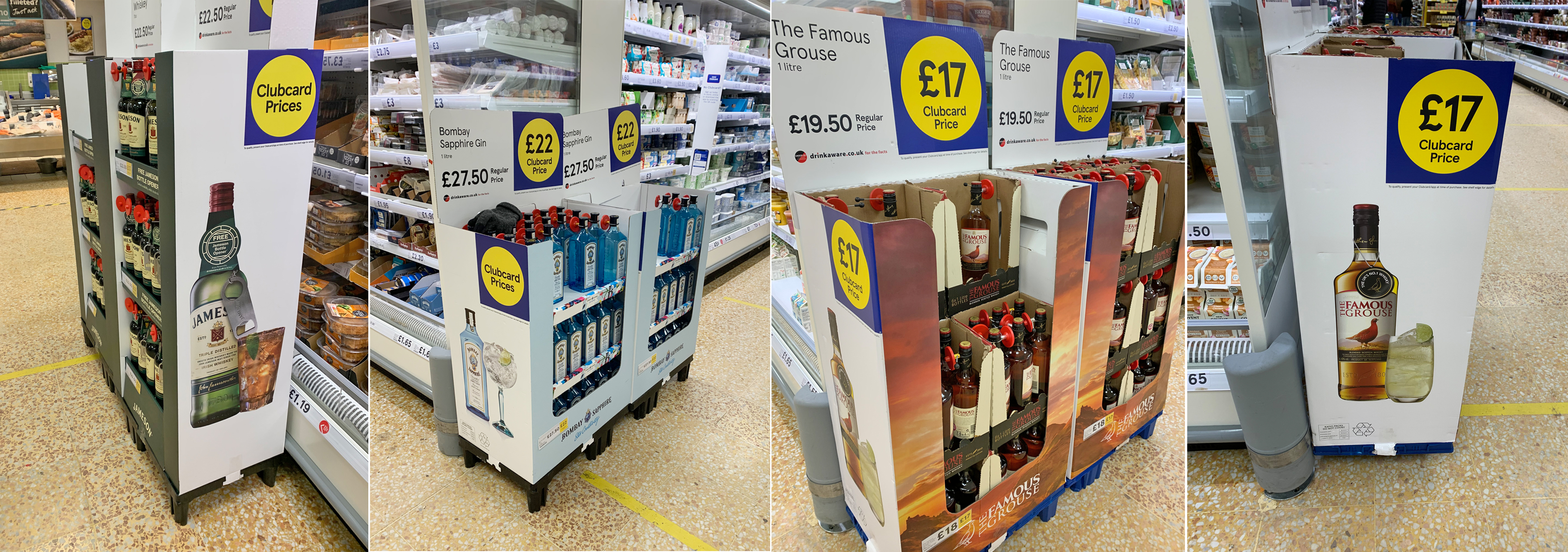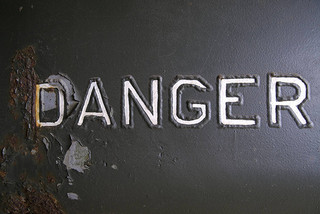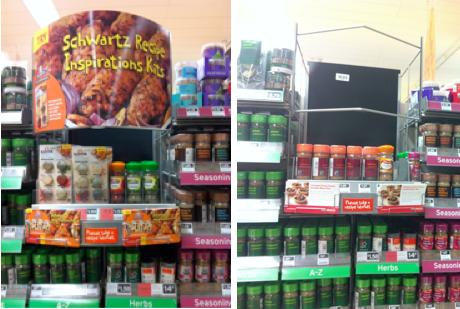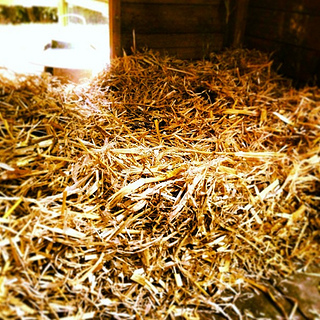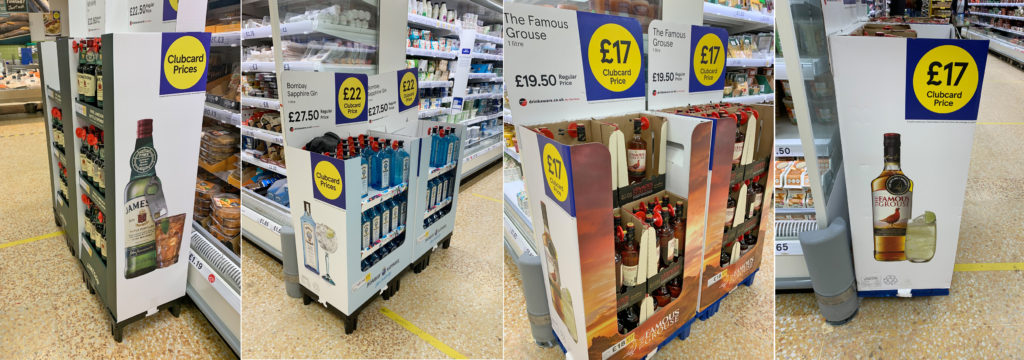 Take a look at the displays above. What do they all have in common? Yes, well spotted – they are all significant spirit brands. But that’s not it. And no, they are not all owned by the same company. So what is the connection? They are all a missed opportunity to effectively communicate with shoppers, drive shopper engagement, inspire shoppers, and create longer-term value for the retailer and the manufacturer. While these displays are fine, they represent a missed opportunity to create truly best in class shopper marketing.
Take a look at the displays above. What do they all have in common? Yes, well spotted – they are all significant spirit brands. But that’s not it. And no, they are not all owned by the same company. So what is the connection? They are all a missed opportunity to effectively communicate with shoppers, drive shopper engagement, inspire shoppers, and create longer-term value for the retailer and the manufacturer. While these displays are fine, they represent a missed opportunity to create truly best in class shopper marketing.
A warning. I might come across a little grumpy in this post. Apologies for that! But it is just a little frustrating to see such a wasted opportunity from brands and retailers who (together) should and could do better. I’m not picking on any brand (as there are many manufacturers represented here). Or any retailer: I could have picked almost any brand in any aisle in any supermarket in any country and the chances are, I’d find missed opportunities to go the extra mile and deliver the extra value. Its just on this day, in this store, I was searching for excellence. I was looking for new examples of best in class shopper marketing to share in our shopper communication training. Instead, I found these.
Engaging shoppers: there is lots to be proud of here
In the interests of fairness and balance (and trying not to completely alienate any of you who might work for these companies!) there is much here to applaud. There are nice quality cardboard prints, with a nice big image of the brand. A good brand image is good practice for shopper communication.
And each image includes a serving suggestion. That’s a nice touch too. It would have been better if there were a few words to describe the drink, a little more to drive shopper engagement, and to inspire me to want to make that drink, but we are already way ahead compared to a simple logo or the brand name!
The displays are located in the meats/fish section, so we’re intercepting shoppers that maybe aren’t planning to buy spirits. Not sure if that is on or off strategy for any of these brands, but let’s give them all the benefit of the doubt and assume that they are targeting shoppers who weren’t planning to buy spirits on this particular day. If this is the case, then the location could be a good strategy too.
Finally, there is a price discount which as everyone knows, is attractive to many shoppers. And one brand is giving away a free key ring, which may or may not be a motivation to buy, but isn’t going to do any harm. So far so good.
LEARN HOW TO CREATE BEST IN CLASS SHOPPER MARKETING NOW
Best in class shopper marketing – going beyond the basics
So come on, Mike, why are you getting so heated? Secondary location? Check. Discount? Check. Big picture of the brand and a lovely delicious looking serving suggestion? Check. What on earth is wrong with this?
And the truth is, there is nothing wrong, per se. Or at least, nothing necessarily wrong (we’ll come to this later!). But the missed opportunity is huge!
To understand why this is the case, let’s take a step back and think about what is the most likely outcome of this activity.
Best in class shopper marketing – who is really going to engage with this?
We’re going to intercept shoppers that weren’t planning to buy the brand today – a location far from the home category creates a huge opportunity here. But the main ‘offer’ is a promotion. Who is likely to buy this? The most likely purchasers of a discount like this will be either people who already use the brand, but perhaps weren’t planning on buying today. Many of these will still have the product in stock. Some people might be new to the brand, but I’d suggest that will be a small percentage of shoppers. For one thing, these are all mega brands that many people (and most category drinkers) will have tried. Experience would suggest that this is unlikely to bring new people into the category.
Best in class shopper marketing – Driving off-take isn’t enough
So a huge amount of the extra volume that these displays will drive will go to the homes of current brand or current category drinkers. Some brand switching might have occurred, but the reality is that most of this will be of short-lived value to the brand owner and potentially of zero (or negative value) to the retailer. In most cases, the net effect is to increase in-home stocks. What’s wrong with that?
Increasing in-home stocks is fantastic for a short-term sales lift. But unless we increase consumption too, all we are doing is mortgaging future sales. Sales go through the roof this month, but the next few months? Consumers still have stock at home. That means that they stop buying.
LEARN HOW TO CREATE BEST IN CLASS SHOPPER MARKETING NOW
Best in class shopper marketing helps avoid the promotion feast-famine cycle
That is painful in the short term, but can also be painful in the long-term too. The brand that now doesn’t sell much for the next few months is going to be under pressure. In a few months they’ll need to do something: and they’ll end up promoting again. The consumer has plenty of stock, but in a few months’ time they see the promotion, and decide to top up the stocks at home. And a feast/famine promotion cycle is born, where more and more sales are made on deal. Promotions like this, if we’re not careful, just train shoppers to seek out our brand on deal. When we’re not on deal they either wait, as they have stocks at home, or buy whichever competitor is on deal.
So how to avoid this cycle? That is where my frustration lies! The way to avoid the promotion feast-famine is to drive consumption too. And this case is such a missed opportunity.
Shopper inspiration – the missed opportunity for best in class shopper marketing
The retailer and brands have already done the hard work – they’ve already for a fabulous location in the store! Out of the category, right next to the ingredients for a meal. A perfect place to inspire! Where are the recipes for using whisky in a steak sauce? Where are the pairing ideas for a cocktail with a chicken dish? I didn’t see them at all!
A little effort to take this to the next level is all that is required. Perhaps shoppers are expected to work that out themselves, but my experience suggests that they won’t. We’ve left the shopper way too much to do. The only shoppers that know what to do will be current category and brand shoppers who see it as an opportunity to increase their stocks!
The images of the drinks as a serving suggestion is great: but the key to great shopper marketing is to make it simple for the shopper. The shopper is in the chilled area: buying steak for dinner, or maybe a pizza. Does a long drink made with whisky automatically resonate with the shopper at that moment? Probably not. So best in class shopper marketing steps in to help shoppers to make the cognitive connection.
A graphic that explains how and why this drink fits into this shopper mission. A suggested pairing. A recipe. And a deal linking pizza to gin, or whisky to ribs, or whatever is the resonance we are trying to connect.
Best in class shopper marketing often creates dissonance then resonance. Dissonance disrupts the shopper on their mission. This display does that. Shoppers aren’t expecting whisky or gin or rum here! That alone disrupts the shopper.
But what is missing for me in the resonance. Without resonance, the disruption is irrelevant. The shopper is looking for a meal solution. They are looking for a great meal. Where does this whiskey fit in? If the shopper can’t make the connection, they walk on. If we can help them make the connection then we get the purchase. And we get additional consumption. And potentially we create a new, long term usage occasion for our brand and category.
What is best in class shopper marketing shopper marketing?
A few year’s ago we came up with a definition of shopper marketing, as follows:
“Shopper marketing is the process of understanding shoppers and using that understanding to develop a marketing mix which influences shopper behavior in such a way as to positively impact consumption of the brand and or category”
I still stand by it. This example might well get some shoppers to buy a product that they weren’t planning to buy. But is it really going to drive a change in long-term consumption? Maybe. But there is a lot more that could have been done!
LEARN HOW TO CREATE BEST IN CLASS SHOPPER MARKETING NOW
The shopper inspiration opportunity requires better collaboration
As I said, there is nothing fundamentally wrong with this at all. Maybe it is exactly what either the retailer or the brand wanted. I have no idea. But I do know that they could have got a lot more out of the investment. When you’ve gone to the trouble of having a display outer carton in full color, of putting the display in the fresh food area, invested in a sizeable discount, let’s collaborate better and go the extra mile. Let’s really connect with shoppers, help them and inspire them to not only buy the product, but use it too.
I know it isn’t easy. We are busy people. Retailers put limits on what we are allowed to do. But at a time when both brands and retailers are under pressure to perform better, this industry needs to step up and grasp every chance it has to really engage and delight consumers and shoppers.
Create best in class shopper marketing now – and long term consumption of your brand will follow
If you want to drive your brand at retail: if you want to create shopper marketing that drives long-term consumption as well as short-term sales, then you need to think consumer and shopper. We need to speak in the shopper’s language, but we need to understand the consumer behind the shopper. Check out our shopper communication program now, or get in touch for more details of how we can totally transform your brand performance by driving consumption and purchase.
